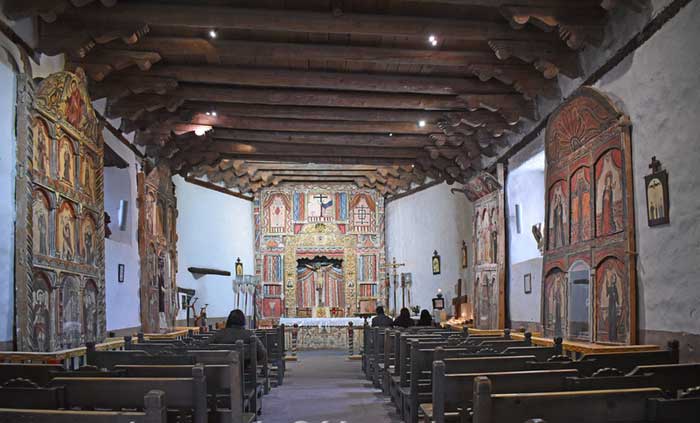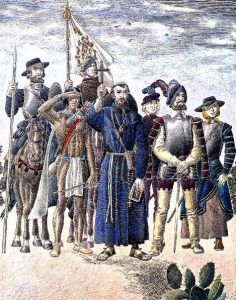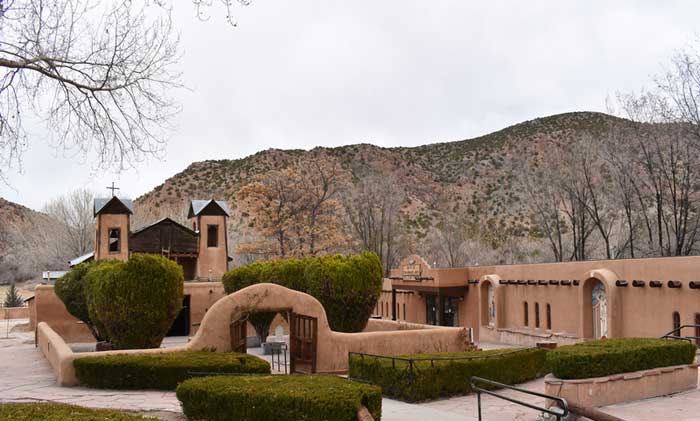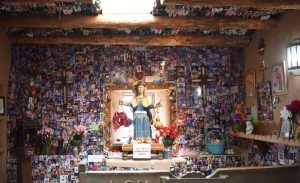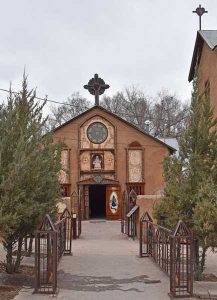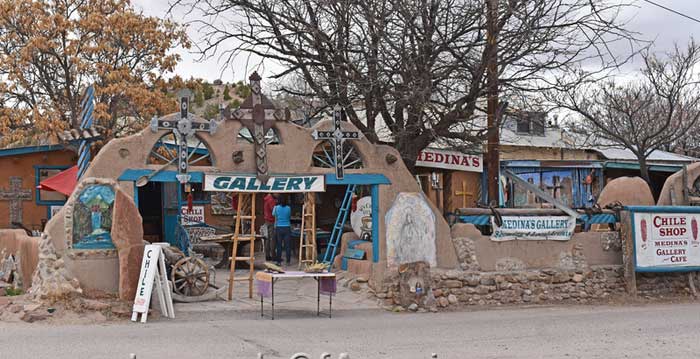Near Santa Cruz, New Mexico, about 25 miles north of Santa Fe, lies an area that has been known for healing powers for centuries. The Tewa believe healing spirits flowed here from hot springs, which left healing earth after drying up. Today, El Santuario de Chimayó is one of the most important Catholic pilgrimage centers in the United States.
The Tewa Indians named the area “Tsi-Mayoh”, now known as Chimayó, after one of four sacred hills above this valley that sits in the Sangre de Cristo Mountains. The Puebloans, who have inhabited the area since the 12th Century, believed they shared the land with supernatural beings.
After the Spanish returned to the area in 1693, being forced out by the Pueblo Revolt of 1680, they regained control and opened up the region for a steady flow of Spanish and Mexican settlers. The new arrivals settled along the Santa Cruz River and Chimayó, which includes many neighborhoods called plazas or Placitas, each with its own name. And it is in one of these neighborhoods, El Potrero de Chimayó, that Don Bernardo Abeyta would discover for himself the healing earth.
It’s believed that Abeyta was devoted to a pilgrimage site in Guatemala where the clay is said to have healing power. According to traditional popular legend, on Good Friday of 1810 Abeyta saw a light beam from one of the hills, and after investigating, found that the light was coming from the ground. After digging there with his bare hands, he found a Crucifix and associated it with Our Lord of Esquipulas, or El Cristo Negro de Esquipulas (the Black Christ of Esquipulas), a Guatemalan representation of the crucifixion associated with a Mayan sacred place of healing earth.
The legend says after notifying Santa Cruz Parish priest Father Fray Sebastian Alvarez, the priest came to El Potrero and took the Crucifix back to the church in Santa Cruz, placing it in a niche of the main altar. The next day it was gone and had miraculously reappeared in its original location in El Potrero. After the same thing happened two more times it was apparent that Our Lord of Esquipulas wanted to reside in El Potrero de Chimayó.
In November of 1813, Abeyta wrote to Father Alvarez seeking to build a Chapel for the people of El Potrero, dedicated to Our Lord of Esquipulas on what the people believed to be the site of the miraculous Crucifix or earth with healing powers. When Alverez sent on the request to the Episcopal See of Durango he mentioned reports of cures from many arriving pilgrims and the church was approved.
Other legends say Abeyta was watching his sheep and contemplating his blessings, though he was sick, when a vision of his patron saint, San Esquipulas, beckoned to him. He went to the place where the saint had appeared and knelt where he was cured immediately. Other people also were cured there, and Abeyta built the chapel in thanks.
And yet another legend says that the crucifix had belonged to a priest from Esquipulas who accompanied the first Spanish settlers in Chimayó. He was killed by Indians and buried in Chimayó. A flood of the Santa Cruz River in the spring of 1810 uncovered the body and the crucifix. People who remembered the priest dedicated the shrine to the Christ of Esquipulas.
Miraculous healings grew at the site to the point a larger Church and Shrine were built in 1816, which continues to stand today. Abeyta’s daughter, Carmen Abeyta de Chaves, inherited the property, and despite attempts to force her to give it to the church, she kept it, since donations from pilgrims were a major source of income. In fact, it remained in the family until financial troubles in 1929 resulted in the property being purchased by the Spanish Colonial Arts Society of Santa Fe who donated it to the Archdiocese of Santa Fe.
El Santuario de Chimayó sits in the center of the small village of El Potrero and is a well-preserved small adobe church with twin front towers with belfries, wooden doors, a wall-enclosed garden, and an arched gate with a cross on top. The interior is a colorful mixture of Spanish and Indian decorations and styles. The nave of the church is decorated with original examples of 19th-century Hispanic religious folk art, including several Santos and religious frescoes. Behind the altar is the miraculous statue of Our Lord Esquipulas. On the left side of the nave are two separate rooms.
The walls of one of the rooms are covered with expressions of thanks for the cure of ailments. Discarded canes, braces, and wheelchairs hanging from the walls of this room are considered proof of the miracles of El Santuario. The other small room contains “el pocito,” a small pit of holy dirt that many characterize as possessing remarkable curative powers. Over the years, people more commonly attribute healings in Chimayó to el pocito than to the Crucifix. It is said that the earth at Chimayó can be mixed with water to make mud and eaten or applied to the skin in order to heal a person of an ailment. Some people take vials of the sand with them as a remembrance of their pilgrimage to Chimayó.
The Shrine of Santa Nino de Atocha, built in 1856, is within walking distance of the Church. United States soldiers and sailors who prayed to the Santo Nino during the notorious Bataan Death March originally started the Easter pilgrimage to the site. In 1945, US servicemen who survived the Bataan Death March began a tradition of walking to El Santuario to thank Santo Niño de Atocha for “delivering them from evil.” That tradition has grown stronger over the years, and now, each year, approximately 300,000 believers from around the world make pilgrimages to the church during holy week. Some walk their way there from as far away as Albuquerque, which is about 90 miles south.
Today, many visitors take small amounts of the “holy dirt” in hopes of cures, or for someone else. They take so much dirt that the church replaces it from a nearby hillside to the tune of up to 30 tons annually. This is done despite the fact the Church takes no position on whether miracles have occurred at the Santuario.
El Santuario de Chimayó was declared a National Historic Landmark in 1970.
More information:
Official Website – Santuario de Chimayo
Street Address:
15 Santuario Drive
Chimayo, NM 87522
Mailing Address:
P.O. Box 235
Chimayo, NM 87522
©Dave Alexander, Legends of America, July 2021.
Also See:
Missions & Presidios of the United States
New Mexico – The Land of Enchantment
Mysterious Objects and Places in America
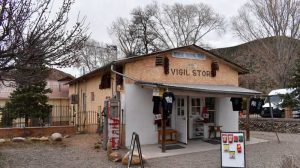
Vigil Store next to the Shrine.
Sources:
Archdiocese of Santa Fe (web archive)
National Park Service
Wikipedia – Chimayo
Wikipedia – El Santuario de Chimayo

